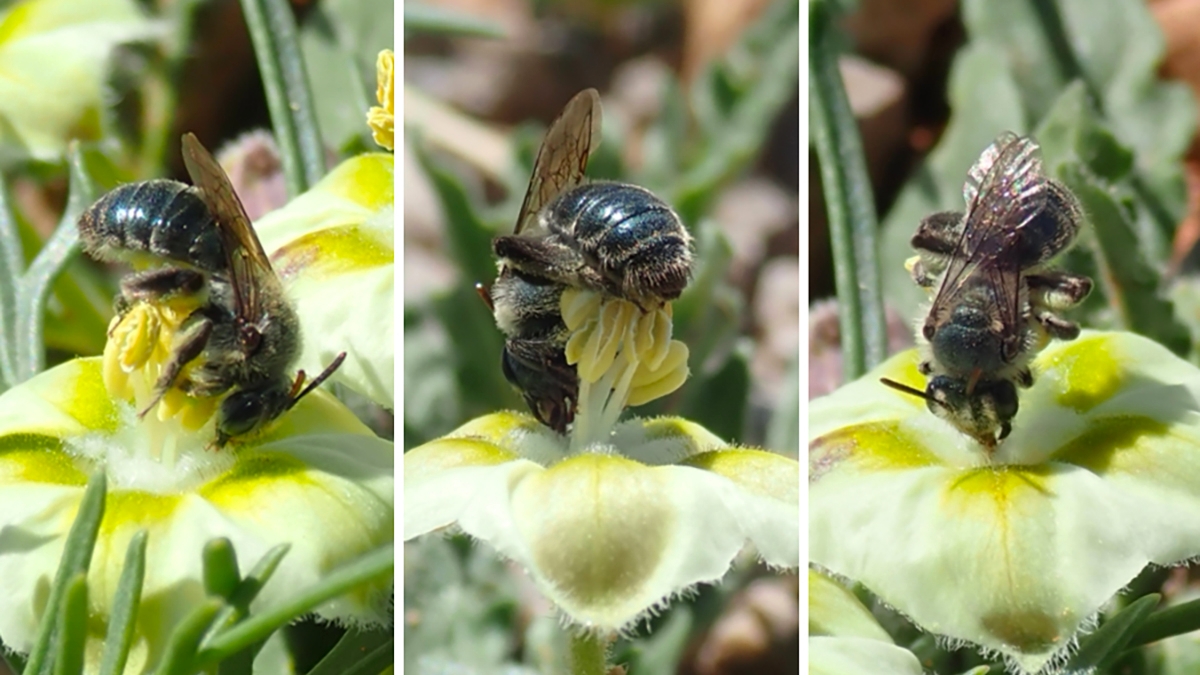
NORMAN, OKLA. – A new species of mining bee has been discovered and named, according to a study recently published in the journal Ecology and Evolution. The newly discovered species, Andrena androfovea, has been documented interacting with plants in the wild in both Oklahoma and Texas, and researchers have now sequenced its genome.
“The process of documenting bee biodiversity started centuries ago, but scientists are still discovering new species all the time” said James Hung, OU assistant professor of biology and co-author of the paper.
According to the U.S. Department of Agriculture, 75-85% of all flowering plants on Earth require animal pollinators to survive and reproduce. Bees are the most important members of this group, especially in temperate ecosystems like those in Oklahoma. There are over 1,500 species of Andrena bees in the world, making it one of the largest genera of animals on the planet. However, this newly discovered species does not fit into any of the existing 104 subgenera of Andrena. That means it is not closely related to any Andrena bees discovered thus far and makes this a significant discovery.
“Subgenera are groups of species that are structurally similar and closely related. This new species, however, is so distantly related to any other Andrena that we think it has formed its own branch on the Andrena family tree about 12.6 million years ago,” said Silas Bossert, assistant professor at Washington State University and lead author of the study. “We know this because we sequenced and compared its genome to those of other bees. Using a technique called ‘molecular clock’, we can approximate how much time has passed since this lineage has separated from the other bees based on differences in its genome.”
According to Hung, creating a new bee subgenus is rare in recent decades and even more uncommon when a new species is discovered. Typically, new subgenera are created due to rearrangement.
Co-author John Neff collected this bee in Texas for several years before confirming its unique position in the Andrena genealogy. During recent discussions, Hung and Neff spoke with Bossert, a molecular systematist who uses DNA to reveal the deep branches of the evolutionary history of bees. The three quickly realized that they were talking about the same bee and knew they had discovered something special.
“New species are often discovered and described based on museum specimens and are often discovered by researchers who didn’t collect the specimens themselves because the original collectors are often field biologists who don’t do deep DNA work,” Hung said. “But I was able to document the way this bee was foraging and interacting with pollinating plants on video and in still images. By combining the molecular data from Neff and Bossert with the video footage I collected, we were able to construct an unusually detailed profile for this species.”
This newly discovered bee is the only species in the genus Andrena that has an affinity to plants in the family Solanaceae (tomato family). Hung was able to capture high-quality video and photo evidence of the bee using its furry abdomen and legs to gather pollen from these plants.
“I observed this matte-blue-colored bee doing a handstand on the flower, sucking nectar with its tongue while scraping the flower with its hind legs and rubbing the flower with its hairy belly,” he said. “This is pretty unusual behavior for a member of the mining bee genus and really helps us showcase the unique evolutionary innovations of this new subgenus.”
In addition to the discovery and documentation of this new species, Hung, who considers himself to be a pollination ecologist, also highlights the importance of native bee conservation and biodiversity research.
“Oklahoma is a treasure trove of biodiversity, but there’s still a lot to be learned about the hidden and undiscovered things in our state,” he said. “More needs to be done to ensure environmental protection for the different habitats, both for the species we know about and those that could be discovered in the future.”
Learn more about Hung’s Pollinator Ecology Lab at the University of Oklahoma and read the full paper in Ecology and Evolution.
About the project
“Evolutionary history and ecology of Andrena (Foveoandrena) androfovea, a new nearctic mining bee (Hymenoptera, Andrenidae) species and subgenus,” DOI no. 10.1002/ece3.70453 is supported by U.S. Department of Interior, Fish and Wildlife Service grant no. F22AC02957. Hung is an assistant professor of biology at the OU Dodge Family College of Arts and Sciences and Oklahoma Natural Heritage Inventory. Bossert is the corresponding author and an assistant professor of entomology at Washington State University. Neff is the director of the Central Texas Melittological Institute.
About the University of Oklahoma
Founded in 1890, the University of Oklahoma is a public research university located in Norman, Oklahoma. As the state’s flagship university, OU serves the educational, cultural, economic and health care needs of the state, region and nation. For more information about the university, visit www.ou.edu.
Three University of Oklahoma graduate students have been named winners of the 2025 Three Minute Thesis competition, which challenges participants to explain their research in three minutes to a non-specialist audience.
Sarah Sharif, a researcher with the University of Oklahoma, has been awarded funding from the U.S. Department of Defense (DoD) to create innovative light detectors that pick up mid-wave and long-wave infrared signals at higher temperatures than previously considered achievable.
A team from OU and WVU recently earned a five-year, $3.5 million grant from the National Institutes of Health to study how concept cigarillos influence the potential for addiction. The results will be used to inform the FDA’s impending flavor ban on cigar products and could have wider-reaching implications for other tobacco products that come in flavors, such as e-cigarettes and tobacco-free nicotine pouches.